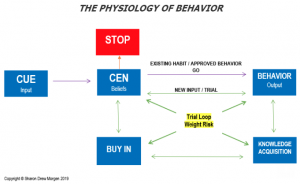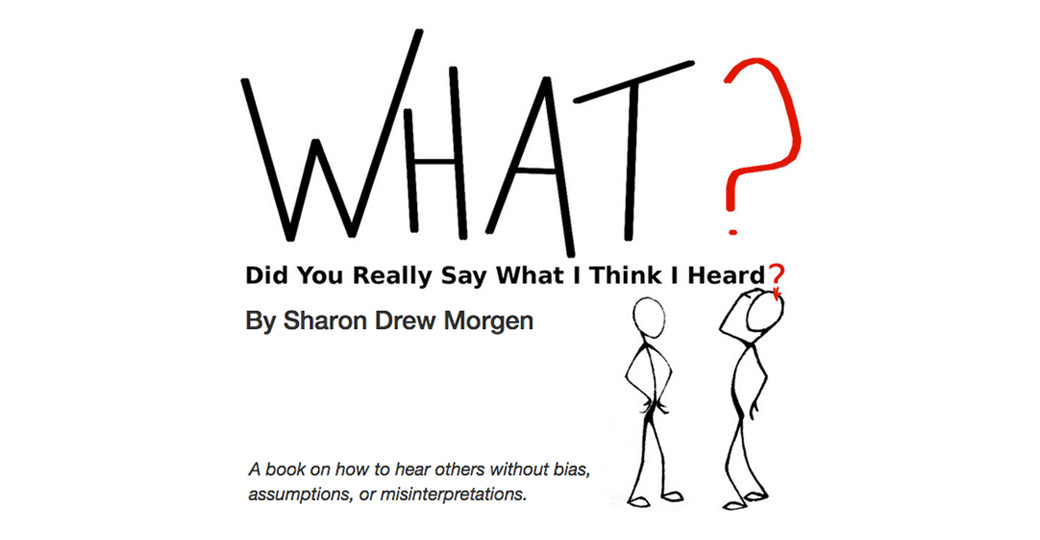You Can’t Change a Behavior by Trying to Change a Behavior, by Sharon-Drew Morgen
 I recently got a call from a noted venture capitalist of healthcare apps.
I recently got a call from a noted venture capitalist of healthcare apps.
DH: I heard you have a model that facilitates permanent behavior change. I wonder if it would work with any of the 15 healthcare apps I’ve invested in.
SD: I do have a model that does that. And it certainly could be used as a front end to conventional behavior change apps to enable users to develop permanent habits by developing neural circuits. What are you using now to help folks change behaviors permanently?
DH. Behavior Modification, but it doesn’t work. There’s no scientific evidence that it works and our analysis concurs. But there’s nothing else to use. Can you help?
It’s a known fact that Behavior Modification has a 3% success rate over time. Sure, people initially lose weight with a behavior-based plan to eat differently. Certainly people stop smoking or get to the gym for a few weeks. But because these new behaviors haven’t been accepted by, or made permanent in, the brain, they cannot succeed over time. And repeating the new in hopes that THIS time it will stick obviously doesn’t work.
Stay tuned for my new book: HOW? Generating new neural circuits for learning, behavior change, and decision making.
Permanent change is a very achievable goal. But we’re approaching the problem from the wrong angle. In this essay I will explain what a behavior is, what change is, how our brain governs them both, and introduce the steps needed to form habits. Believe it or not, it’s mechanical.
THE PROBLEM WITH BEHAVIOR MODIFICATION
Lately I’ve heard several Behavioral Scientists on the radio, all offering Behavior Modification techniques to habituate new behaviors by, well, habituating new behaviors. They ‘remove barriers’, suggest ‘momentum’, offer ‘promoting forces/restraining forces’, and propose ‘behavioral interventions’ such as keeping weights at your desk so you can ‘lift’ during Zoom calls. All meant to motivate behavior change – through behavior change. I suspect Einstein might have something to say about that.
The problem is the premise. Behavior Mod’s core assumptions are actually contrary to brain science. It assumes that by merely repeating (and repeating and repeating) new ways to accomplish something that’s been problematic, permanent change will result that can be maintained over time. But it doesn’t. And it can’t.
Certainly we’ve all tried. We’ve learned the hard way that we can’t lose weight permanently by trying to lose weight. Or stop smoking by trying to stop smoking. We promise ourselves we’ll be disciplined ‘this time’. But our discipline isn’t the problem. We have no circuits to translate our wishes into actions automatically. Our brain makes us fail.
DIFFERENT THINKING REQUIRED
The reason we fail is simple: we’re not making the necessary adjustments to the neural pathways that prompt behaviors to begin with.
I’ll start with an analogy. Let’s say you purchase a forward-moving robot, use it for a while, then decide you want it to move backward. You tell it why a ‘backwards’ functionality would enhance it, show it slides and presentations of other robots that move backwards, and attempt to push, cajole, and offer rewards. Nope. It won’t move backward. But if you program it differently, it will.
What about changing a chair into a table. You put red plastic into a machine that is programmed to spit out a red plastic chair. Once the chair is produced, you can’t make it a table. But you can create a table if you program the machine appropriately at the start.
Changing habits by trying to change habits is merely attempting to change the outcome – the output, the habit, the behavior, the robot, the chair – but failing to reprogram the brain with different instructions to create something new.
Sounds obvious. But that’s not what behaviorists do: the Behavior Mod approach suggests we get the robot to move backward by pushing it (and pushing it and pushing it) assuming the repetition will cause permanent change. As you know, it doesn’t work.
WHAT IS A BEHAVIOR?
To understand the full scope of the problem it’s helpful to understand what, exactly, a behavior is. They don’t just arise because we want them to. Behaviors are the output of our brain’s signaling system, the response to input instructions that travel as electrochemical signals down a fixed neural pathway and hook up with a set of circuits that translates the signals into something tangible.
Where do behaviors originate? Behaviors are Beliefs in action, physical representations of our core identity factors. Our politics represent our Beliefs. The way we dress, talk; the professions we choose; where we travel and who we marry. Everything we do represents who we are.
As the foundational factor in what we do and think, Beliefs must be factored in when considering change or forming a new habit. Current Behavior Mod approaches circumvent Beliefs and therein lie the problem.
There is actual science on how behaviors get generated and why we automatically repeat behaviors even when we don’t want to. Here’s a quote from noted Harvard neuroscientist Richard Masland in We Know It When We See It to set the stage:
Our brain has trillions of cell assemblies that fire together automatically. When anything incoming bears even some of the characteristics [of operational circuits], the brain automatically fires the same set of synapses [triggering the same behavior]. (pg 143).
Here’s a simplified version of how to convince the brain to make the changes that lead to new habits. It explains how behaviors occur and where change comes from. For a more complete explanation and tools to actually create new brain circuitry for change, watch for my new book HOW? coming out soon.
NEUROLOGICAL PATHWAY FROM INPUT TO OUTPUT
Generally, each behavior starts off as an input – an idea or command, thought or story – that enters our brain as a meaningless puff of air, an electrochemical vibration (a ‘message’). To keep us congruent, the input gets evaluated against our Mental Models and Beliefs before going further. Is this input a risk? Is it congruent with our values?
If the idea goes against who we are, it gets rejected or resisted. If the vibration is accepted, it gets turned into signals that then seek out (among our 100 trillion synapses) similar-enough circuits that translate them into action or output – a behavior. Specifically, our brains:
-
- receive input vibrations (from conversations, thoughts, reading, ideas, internal commands) and
- compare/test these against foundational Beliefs, norms, and history, after which they
- get turned into signals that get
- matched with the closest, ‘similar enough’ neural circuits
- that translate them into output/action/behavior.
As you can see, whichever neural circuits receive the signals are the translators that determine what we hear, see, know, and do. Simply stated it looks like this:
Input -> Risk check -> Signal creation and Dispatch -> Output
The time it takes a message to go from an input to an output takes 5 one-hundredths of a second. It’s pretty automatic. And obviously, once an output, it can’t be changed. Change begins when initiated from the input.
THE NEED FOR VALUES-BASED CONGRUENCY
The next important piece is why repetition won’t cause new (permanent) habits. When a wholly new input enters, it requires a new relevancy check. Sadly – and the reason new activity fails when Behavior Mod is attempted – if anything tries to change the status quo without being checked for relevance, our brain discards the new input because it may carry risk! The new isn’t sustainable without new circuitry.
When we try to create new habits by merely ‘doing’ new behaviors without sending new and different input instructions we cannot generate permanent change because there are no new circuits to administer it!
The good news is that the brain is always willing to create new circuits for new behaviors. It’s called Neurogenesis.
CREATING NEW PROGRAMMING, NEW SIGNALS, NEW BEHAVIORS
To change behaviors permanently, start with new input messages:
-
-
- create a new belief-based input/message that
- generates new signals which
- create or discover a different arrangement of circuits
- which translate them into new/different behaviors.
-
I’ll explain with a story. A friend said, “I’ve been telling myself I’m a Fat Cow recently. That means it’s time for me to go on another diet.” Obviously this input would lead her to the same circuits (and results) that it used for past diets that she failed at. But if she changed her input signal and told herself instead:
‘I am a healthy person who will research best nutrition choices for my body type and lifestyle and have the discipline to eat the best foods for the rest of my life.’
she would end up with a different set of circuits and different output/behaviors.
Our outputs, our behaviors, are merely responses to inputs that our brain has checked out as congruent with who we are. So one way to change a behavior is to change the incoming messaging to one that is Belief-based and takes into account all the elements (Mental Models, history, norms, experience) that might cause risk to the system. Once it’s approved, it will automatically generate new circuits and new, habituated, behaviors.
My new book How? Generating new neural pathways for learning, behavior change, and decision making, will teach you several models to formulate the neural circuits you need to help you change habits permanently.
I am passionately interested in enabling people to consciously design new signaling instructions for their brains to output any new habits they seek. My wish is to work with healthcare providers and apps for exercise, healthy eating, meditation and decision making to aid folks seeking to achieve greater health and success.
If you want to collaborate, or have questions, contact me to discuss ways we can engage those seeking permanent change. sharondrew@sharondrewmorgen.com.
_______________________
Sharon-Drew Morgen is a breakthrough innovator and original thinker, having developed new paradigms in sales (inventor Buying Facilitation®, listening/communication (What? Did you really say what I think I heard?), change management (The How of Change™), coaching, and leadership. She is the author of several books, including her new book HOW? Generating new neural circuits for learning, behavior change and decision making, the NYTimes Business Bestseller Selling with Integrity and Dirty Little Secrets: why buyers can’t buy and sellers can’t sell). Sharon-Drew coaches and consults with companies seeking out of the box remedies for congruent, servant-leader-based change in leadership, healthcare, and sales. Her award-winning blog carries original articles with new thinking, weekly. www.sharon-drew.com She can be reached at sharondrew@sharondrewmorgen.com.
Sharon Drew Morgen September 8th, 2025
Posted In: Change Management, Communication


